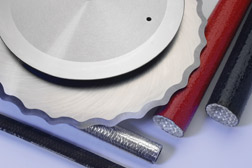Hose Cutting Tips
by Eric Pfeiffer
 Anyone who must cut hydraulic hose knows that it is a demanding application. Hydraulic hose has to be strong enough to handle high fluid pressures, pressure cycling, repeated bending, high temperatures and remain in service for years. The same material characteristics that make hydraulic hose stand up to such tough conditions also make it difficult to cut. Therefore, most hose cutoff machines have used an abrasive wheel. The wheel runs at high speed to grind or melt away rubber and other soft materials in the hose and high-strength steel reinforcement wires. Abrasive wheels generate heat, smoke and debris that can contaminate hydraulic systems.
Anyone who must cut hydraulic hose knows that it is a demanding application. Hydraulic hose has to be strong enough to handle high fluid pressures, pressure cycling, repeated bending, high temperatures and remain in service for years. The same material characteristics that make hydraulic hose stand up to such tough conditions also make it difficult to cut. Therefore, most hose cutoff machines have used an abrasive wheel. The wheel runs at high speed to grind or melt away rubber and other soft materials in the hose and high-strength steel reinforcement wires. Abrasive wheels generate heat, smoke and debris that can contaminate hydraulic systems.
Steel blades are a cleaner, more effective way to cut hose. The circular blade slices the hose rather than cutting a path through it, so it does not leave debris in the hose. The cutting operation set-up causes the hose to be bent, applying tension to the hose so that it pulls away from the blade during the cut. This bending action makes cutting easier and keeps the hose ends from rubbing against the spinning blade. Because the hose opens up faster than the knife penetrates, the hose does not pinch the blade. Since there is little contact between the sides of the blade and the hose, no smoke is generated.
Differences between blades
Circular knife blades are made of high-speed tool steel and come in two styles – smooth beveled edge and wavy scalloped edge. Each was developed for a specific application.
A smooth beveled edge blade can cut all types of hose because it creates the least amount of dust. However, if you’re cutting any hose that has a significant amount of steel wiring, such as 4- and 6-wire hose, the knife edge will dull quickly. A dull blade requires greater operator force to cut, meaning the cut must be made more slowly. The ideal
applications for a smooth edge knife are cutting industrial rubber hose with no steel in it. Other uses include large diameter cloth hoses with helical wire and exterior steel braided hose where the braiding is taped, annealed, or welded in the machine before the cut is made.
A wavy scalloped edge knife provides a more aggressive cutting action, using the wavy edge to make interrupted cutting contact into the hose. This interrupted cutting action severs the steel braiding inside a hose and requires less operator pressure during the cut than a smooth edge blade. Typically, wavy scalloped blades can cut all types of hydraulic, pneumatic, polyurethane, PVC and thermoplastic hose.

Eric Pfeiffer is director of sales and marketing for Hyde Industrial Blade Solutions. Reach him at (508) 764-4344 or epfeiffer@hydetools.com.
This article originally appeared in the March/April 2012 issue of Industrial Supplymagazine. Copyright 2012, Direct Business Media.













